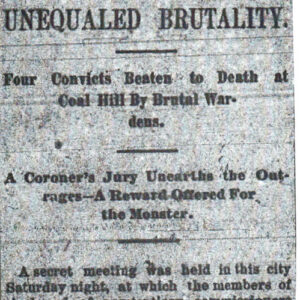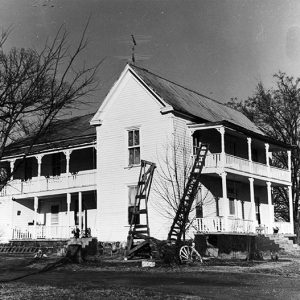calsfoundation@cals.org
Coal Hill (Johnson County)
| Latitude and Longitude: | 35°26’14″N 093°40’23″W |
| Elevation: | 472 feet |
| Area: | 2.93 square miles (2020 Census) |
| Population: | 820 (2020 Census) |
| Incorporation Date: | January 22, 1880 |
Historical Population as per the U.S. Census:
|
1810 |
1820 |
1830 |
1840 |
1850 |
1860 |
1870 |
1880 |
1890 |
1900 |
|
– |
– |
– |
– |
– |
– |
– |
200 |
802 |
1,341 |
|
1910 |
1920 |
1930 |
1940 |
1950 |
1960 |
1970 |
1980 |
1990 |
2000 |
|
1,229 |
1,057 |
1,169 |
1,040 |
873 |
704 |
733 |
859 |
912 |
1,001 |
|
2010 |
2020 |
|
|
|
|
|
|
|
|
|
1,012 |
820 |
|
|
|
|
|
|
|
|
For a short time in the late nineteenth century, Coal Hill, located on U.S. Highway 64 in western Johnson County, was unofficially the largest incorporated city in the county. By the 1880s, it was a major coal-producing area, leading the state in tons mined. In 1888, it became the center of a state investigation into the mistreatment of convict labor employed in the mines. The investigation helped lead to the abolition of the much abused system.
Post Reconstruction through the Gilded Age
Western Arkansas is home to large coal deposits; however, until the construction of the Little Rock and Fort Smith Railroad into the area in the late 1800s, there was no reliable way to get the extracted coal to market. Johnson County, where coal had first been discovered on Spadra Creek in 1840, became an important part of the industry. By 1888, less than ten years after the arrival of the railroad, approximately 47 million tons of coal had been shipped from the area.
As the center of a 170,000-acre coal basin, the area that would become Coal Hill attracted workers and investors. Once mining became profitable, workers began to arrive, with towns developing near the mines. At one time, the area was called Whalen’s Switch, after a railroad siding and switch that had been constructed to exploit the area coal field. When the community was petitioning for a post office in 1876, the name Eureka was suggested. However, the name was rejected due to the existence of Eureka Springs (Carroll County). Moseville was suggested to honor Mose Butts, an early settler who had surveyed a six-block, ninety-six-lot town site on September 26, 1876. It is believed that Butts, in turn, suggested Coal Hill.
Soon after the first significant commercial mining began in 1876, a number of companies, including the Ouita Coal Company, which eventually became the largest in the area, began operation. A town was quickly established near the prosperous mines. George Williford is believed to have constructed the first house in 1876. On May 9, 1876, Aaron Matthews and William Whittle were granted a license to sell liquor for Grant Township, resulting in what may have been the town’s first business. By 1878, the town businesses, which occupied both sides of the railroad track, included four saloons, a shoe repair shop, three general merchandise stores, a post office, and a depot. Early on, the town developed a somewhat rough reputation, being known for open gambling and drunkenness and fighting in the streets.
In 1878, a petition with the signatures of thirty-one citizens was submitted requesting incorporation. In January 8, 1880, incorporation was granted. Turner Butts was chosen as the town’s first mayor.
A school was established in the 1870s, and a new building, also used by the Masons, was constructed in 1879. After the school burned in 1882, classes were held in several locations, including a saloon, until a new structure was completed in 1894. It was replaced in the 1890s, but this new building also burned after being struck by lightning. A third building was occupied in 1909. Today, a consolidated system operates as the Westside School District.
With the further development of the railroad in the 1880s, the town grew rapidly. In 1884, the Arkansas Improvement Company acquired area land and began promoting the area. A two-and-one-half-mile spur line was built to the Ouita Coal Company mines in 1884. Sometimes as many as ten trains occupied the local rail yard. An 1887 promotional booklet described Coal Hill as facing “a bright future if the proper capital and ability are devoted to the development of its rich natural advantages.” That same year, railroad land agents were established in the town, offering some 500 lots for sale. By 1890, the population had grown to more than 800, increasing by another 500 during the next decade, before experiencing a decline by 1910. In 1887, the town led the state in coal production, shipping 45,998 tons that year and increasing to 67,963 the next year.
Much of the labor was provided by African Americans who lived in a segregated community on the west side of town. More than 200 black citizens lived in the community in 1890. Additional labor was provided by convicts from the often abused convict lease system. Reports of numerous atrocities resulted in an 1888 state investigation of leased convicts employed in some of the Coal Hill mines.
Over the years, a number of newspapers were published in the town. The Arkansas Valley was first published on November 3, 1885. After being sold, it was published for a short time as The Lancet. Other late 1800s papers were the Monitor, Phonograph, Banner, Arkansas Spy, Inquirer, Democrat, and Phoenix. All of these papers supported the Democratic Party. However, for a brief run in 1897, a Populist paper titled Rustler was published.
Early Twentieth Century through the Modern Era
Coal Hill continued to prosper until a decline in the county coal mining industry by the early 1920s. During that time there were twenty-three county coal mines in operation. By the mid-1930s, the number had declined to just eight. Though Coal Hill was the second-largest Johnson County town in the 1920s and 1930s, people began to move away to seek employment elsewhere. By 1960, the population of 704 stood as its twentieth-century low.
With the growth of nearby Clarksville (Johnson County), many people have begun to move to Coal Hill seeking a smaller school for their children and a more rural style of living. In the twenty-first century, the exploration for natural gas in the area has also brought attention to the Coal Hill area. One exploration company, Arkansas Oilfield Services, Inc., was established nearby in 2006. As of 2011, the town consists of approximately twenty-four businesses and a consolidated school district that numbers approximately 600 students.
For additional information:
Brooks, James C. People, Places and Happenen’s: Clarksville, Johnson County and Arkansas. Clarksville, AR: 1993.
“Johnson County.” Johnson County Historical Society Journal 1 (January 1975): 11–13.
Langford, Ella Molloy. History of Johnson County: The First Hundred Years. Clarksville, AR: Johnson County Historical Society, 1981.
Logan, S. H. “What I Know About Coal Hill.” Johnson County Historical Society Journal 1 (October 1975): 25–29.
Mike Polston
Encyclopedia of Arkansas History & Culture
 Convict Lease Article
Convict Lease Article  Johnson County Map
Johnson County Map  Taylor Hill Hotel
Taylor Hill Hotel 




Comments
No comments on this entry yet.